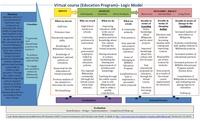Digital pedagogy

Digital pedagogy is when teachers and students use computers, phones or other electronic devices to help them learn and teach. It's like having a teacher who can talk to you through your computer or phone, and show you pictures and videos to help you understand things better.
Let's say you have a reading assignment. With digital pedagogy, instead of reading a physical book, you might be asked to read an ebook on your tablet or phone. This ebook could have interactive features like quizzes and videos that help you understand the reading better. You can also use digital tools to take notes or highlight important parts of the text.
This method of learning is particularly helpful for students who can't be in the classroom all the time. With digital pedagogy, you can attend classes and learn from anywhere as long as you have a device and an internet connection. This means that students who are home-schooled, studying abroad or have busy schedules can still learn.
Digital pedagogy can also be used to make learning more fun and engaging. For example, if you're studying history, you might play a game that takes you back to ancient Egypt. Or if you're learning about science, you might watch an animation that explains how the human body works.
In summary, digital pedagogy is a way of using technology to make learning more engaging, accessible and fun.
Let's say you have a reading assignment. With digital pedagogy, instead of reading a physical book, you might be asked to read an ebook on your tablet or phone. This ebook could have interactive features like quizzes and videos that help you understand the reading better. You can also use digital tools to take notes or highlight important parts of the text.
This method of learning is particularly helpful for students who can't be in the classroom all the time. With digital pedagogy, you can attend classes and learn from anywhere as long as you have a device and an internet connection. This means that students who are home-schooled, studying abroad or have busy schedules can still learn.
Digital pedagogy can also be used to make learning more fun and engaging. For example, if you're studying history, you might play a game that takes you back to ancient Egypt. Or if you're learning about science, you might watch an animation that explains how the human body works.
In summary, digital pedagogy is a way of using technology to make learning more engaging, accessible and fun.
Related topics others have asked about:
